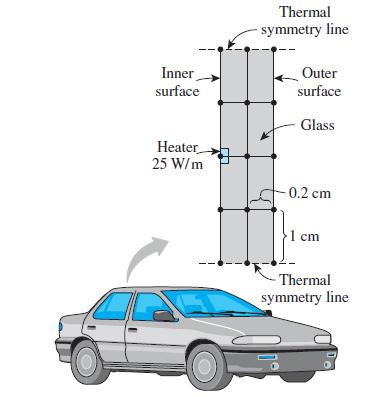Repeat Prob. 5116 using the implicit method with a time step of 1 min. Data from problem
Question:
Repeat Prob. 5–116 using the implicit method with a time step of 1 min.
Data from problem 116
A common annoyance in cars in winter months is the formation of fog on the glass surfaces that blocks the view. A practical way of solving this problem is to blow hot air or to attach electric resistance heaters to the inner surfaces. Consider the rear window of a car that consists of a 0.4-cm-thick glass (k = 0.84 W/m · K and α = 0.39 × 10-6 m2/s). Strip heater wires of negligible thickness are attached to the inner surface of the glass, 4 cm apart. Each wire generates heat at a rate of 25 W/m length. Initially the entire car, including its windows, is at the outdoor temperature of To = - 3°C. The heat transfer coefficients at the inner and outer surfaces of the glass can be taken to be hi = 6 and ho = 20 W/m2 · K, respectively. Using the explicit finite difference method with a mesh size of Δx = 0.2 cm along the thickness and Δy = 1 cm in the direction normal to the heater wires, determine the temperature distribution throughout the glass 15 min after the strip heaters are turned on. Also, determine the temperature distribution when steady conditions are reached.
Step by Step Answer:

Heat And Mass Transfer Fundamentals And Applications
ISBN: 9780073398181
5th Edition
Authors: Yunus Cengel, Afshin Ghajar





